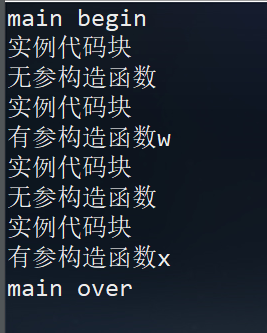Java学习:十一.this和static---实例代码块
本文共 595 字,大约阅读时间需要 1 分钟。
一.语法格式
{ Java代码块1; Java代码块2; … } 二.特点 只要调用构造函数,必然在构造函数调用之前调用实例代码块。public class InstanceTest { public static void main(String[] args) { System.out.println("main begin"); new InstanceTest(); new InstanceTest("w"); new InstanceTest(); new InstanceTest("x"); System.out.println("main over"); } { System.out.println("实例代码块"); } public InstanceTest() { System.out.println("无参构造函数"); } public InstanceTest(String name) { System.out.println("有参构造函数"+name); }} 结果:
 从结果中可以看出,实例代码块在构造函数之前调用,而且调用的次数可以不止一次。 三.作用 为程序员准备的时机,叫做对象构造时机。
从结果中可以看出,实例代码块在构造函数之前调用,而且调用的次数可以不止一次。 三.作用 为程序员准备的时机,叫做对象构造时机。 转载地址:http://uxlk.baihongyu.com/
你可能感兴趣的文章
Netty基础—7.Netty实现消息推送服务二
查看>>
Netty基础—8.Netty实现私有协议栈二
查看>>
Netty多线程 和 Redis6 多线程对比
查看>>
Netty学习总结(2)——Netty的高性能架构之道
查看>>
Netty学习总结(3)——Netty百万级推送服务
查看>>
Netty学习总结(5)——Netty之TCP粘包/拆包问题的解决之道
查看>>
Netty学习总结(6)——Netty使用注意事项
查看>>
Netty实现Http服务器
查看>>
Netty客户端断线重连实现及问题思考
查看>>
Netty工作笔记0001---Netty介绍
查看>>
Netty工作笔记0003---IO模型-BIO-Java原生IO
查看>>
Netty工作笔记0006---NIO的Buffer说明
查看>>
Netty工作笔记0007---NIO的三大核心组件关系
查看>>
Netty工作笔记0008---NIO的Buffer的机制及子类
查看>>
Netty工作笔记0009---Channel基本介绍
查看>>
Netty工作笔记0011---Channel应用案例2
查看>>
Netty工作笔记0012---Channel应用案例3
查看>>
Netty工作笔记0013---Channel应用案例4Copy图片
查看>>
Netty工作笔记0014---Buffer类型化和只读
查看>>
Netty工作笔记0015---MappedByteBuffer使用
查看>>